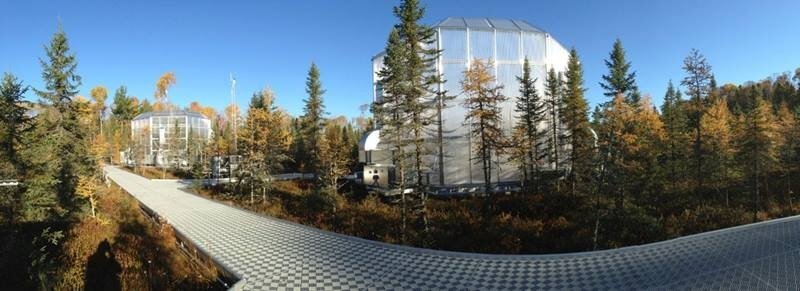The dynamics and availability of nutrients in soil can limit the growth of plants and microbes. These forces underpin how ecosystems respond to changing environmental conditions. Researchers investigated climate impacts on peatland nutrient availability as part of the large-scale Spruce and Peatland Responses Under Changing Environments (SPRUCE) experiment. The study is published in the journal Ecosystems.
With SPRUCE, researchers can conduct experiments on warming and carbon dioxide levels in a nutrient-limited bog. SPRUCE is at the southern end of the range of boreal peatland found throughout the northern hemisphere. The experiment found that above- and below-ground warming exponentially increased the availability of nutrients throughout the below-ground peat layers. This was especially true in recent years, as the carpet of Sphagnum mosses at the peat surface died in the warmest experimental treatments. However, elevated carbon dioxide did not affect the availability of nutrients.
Peatlands cover less than 3 percent of the world’s land surface, but they hold at least one third of global soil carbon in deep deposits of peat. Increases in peat nutrient availability in response to warming could affect the growth and decomposition of plant and microbial communities. This would in turn affect how peatland stores carbon.
However, the magnitude and timing of the observed increases in peat nutrient availability with warming in the SPRUCE experiment were not captured in the virtual space of ELM-SPRUCE. This is a special version of the Energy Exascale Earth System Model (E3SM) land model (ELM) for simulating the unique vegetation, hydrology, and soil in peatland ecosystems. This mismatch pinpoints a need for improved model mechanisms of how nutrients move in order to predict future peatland climate responses.
Warming is expected to increase the net release of carbon from peatland soils, contributing to additional future warming. This positive feedback may be moderated by the response of peatland vegetation to rising atmospheric carbon dioxide or to increased soil nutrient availability. Researchers from Oak Ridge National Laboratory, Michigan State University, Michigan Technological University, Boise State, the University of Zurich, the University of Tennessee, Knoxville, and the USDA Forest Service asked two questions about this subject.
First, they asked whether a gradient of whole-ecosystem warming (an increase from 0 degrees C to 9 degrees C) would increase plant-available nitrogen and phosphorus in an ombrotrophic bog in Northern Minnesota. Second, they examined whether elevated carbon dioxide would modify the nutrient response.
They tracked changes in plant-available nutrients across space and time and compared them with other nutrient pools. Afterwards, the researchers assessed whether nutrient warming responses were captured by a point version of the land-surface model, ELM-SPRUCE.
The researchers found that warming exponentially increased plant-available ammonium and phosphate, but that nutrient dynamics were unaffected by elevated carbon dioxide.
The warming response increased by an order of magnitude between the first and fourth year of the experimental manipulation, perhaps because of dramatic mortality of Sphagnum mosses in the surface peat of the warmest treatments. Neither the magnitude nor the temporal dynamics of the responses were captured by ELM-SPRUCE. Relative increases in plant-available ammonium and phosphate with warming were similar, but the response varied across bog microtopography (raised hummocks and depressed hollows) and with peat depth.
Plant-available nutrient dynamics were only loosely correlated with inorganic and organic porewater nutrients, likely representing different processes. Future predictions of peatland nutrient availability under climate change scenarios must account for dynamic changes in nutrient acquisition by plants and microbes, as well as microtopography and peat depth.
More information:
Colleen M. Iversen et al, Whole-Ecosystem Warming Increases Plant-Available Nitrogen and Phosphorus in an Ombrotrophic Bog, Ecosystems (2022). DOI: 10.1007/s10021-022-00744-x
Citation:
Warming strongly increases nutrient availability in a nutrient-limited bog (2023, April 4)
retrieved 4 April 2023
from https://phys.org/news/2023-04-strongly-nutrient-availability-nutrient-limited-bog.html
This document is subject to copyright. Apart from any fair dealing for the purpose of private study or research, no
part may be reproduced without the written permission. The content is provided for information purposes only.
For all the latest Science News Click Here
For the latest news and updates, follow us on Google News.

